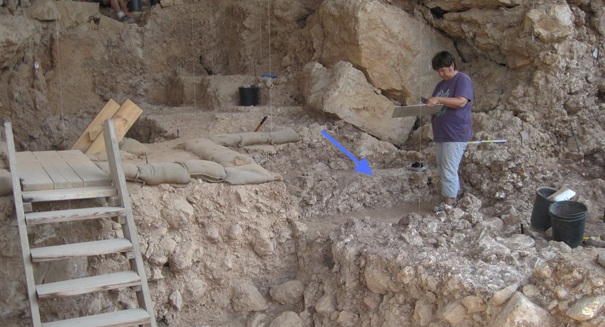
Around the hearth area, as well as inside it, the archaeologists discovered great quantities of flint tools that were clearly utilized for cutting meat.
According to a news release from the Weizmann Institute of Science, a 300,000-year-old hearth has been found in the Qesem Cave, an archaeological location near present-day Rosh Ha’ayin.
It is widely believed that humans discovered fire over a million years ago. What has been less clear to researchers is when humans really started to control and utilize fire for their daily needs. This new discovery may help solve this mystery. The finding also suggests that the prehistoric humans who repeatedly built fire in the spot already had an advanced social structure and intellectual capacity.
Professors Avi Gopher and Ran Barkai of Tel Aviv University are the leaders of a team that has been digging in Qesem Cave since 2000. Dr. Ruth Shahack-Gross of the Kimmel Center for Archaeological Science at the Weizmann Institute has been a part of the research since digging started, and she gathers samples on-site for later examination in the lab.
Shahack-Gross recognized a thick deposit of wood ash in the center of the cave. Utilizing infrared spectroscopy, she and her fellow researchers were able to identify that mixed in with the ash were bits of bone and soil that had been heated to extremely high temperatures. In other words, the researchers had discovered evidence that the area had been the location of a large hearth.
Next, Shahack-Gross examined the micro-morphology of the ash. To accomplish this, she drew out a cubic piece of sediment from the hearth and hardened it in the lab. Then she cut it into very thin slices and placed them under a microscope to determine the specific makeup of the materials in the deposit and show how they were formed. With this technique, she was able to differentiate a number of micro-strata in the ash — proof that a hearth was utilized again and again over time.
Around the hearth area, as well as inside it, the archaeologists discovered great quantities of flint tools that were clearly utilized for cutting meat. However, the flint tools discovered just a few meters away had a dissimilar shape, created for other activities. Also in and around the area were great quantities of burnt animal bones — additional proof of repeated fire use for cooking meat.
The researchers have revealed that this organization of different “household activities” into various parts of the cave indicates an organization of space that is typical of modern humans. This implies that the cave was a base camp that prehistoric humans returned to repeatedly.
“These findings help us to fix an important turning point in the development of human culture – that in which humans first began to regularly use fire both for cooking meat and as a focal point – a sort of campfire – for social gatherings,” Shahack-Gross notes. “They also tell us something about the impressive levels of social and cognitive development of humans living some 300,000 years ago.”
The researchers posit that these findings are indications of significant alterations in human behavior and biology that started with the emergence in the region of new forms of culture approximately 400,000 years ago.
The study’s findings are described in greater detail in the Journal of Archaeological Science.
Leave a Reply